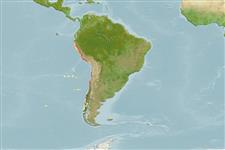Cephalopoda |
Octopoda |
Octopodidae | Octopodinae
Environment: milieu / climate zone / depth range / distribution range
Ecology
Benthic; depth range 0 - 200 m (Ref. 87801). Temperate
Southeast Pacific: Chile and Peru.
Length at first maturity / Size / Weight / Age
Maturity: Lm ? range ? - ? cm
It is found in tide pools on rocky substrates from the intertidal area to a depth of 200 meters. Feeds on amphipods and shrimp (Ref. 87801).
Life cycle and mating behavior
Maturity | Reproduction | Spawning | Eggs | Fecundity | Larvae
Members of the class Cephalopoda are gonochoric. Male and female adults usually die shortly after spawning and brooding, respectively. Mating behavior: Males perform various displays to attract potential females for copulation. During copulation, male grasp the female and inserts the hectocotylus into the female's mantle cavity where fertilization usually occurs. Life cycle: Embryos hatch into planktonic stage and live for some time before they grow larger and take up a benthic existence as adults.
Bisby, F.A., M.A. Ruggiero, K.L. Wilson, M. Cachuela-Palacio, S.W. Kimani, Y.R. Roskov, A. Soulier-Perkins and J. van Hertum. 2005. (Ref. 19)
IUCN Red List Status (Ref. 130435)
CITES status (Ref. 108899)
Not Evaluated
Not Evaluated
Threat to humans
Human uses
| FishSource |
Tools
More information
Age/Size
Growth
Length-weight
Length-length
Morphology
Larvae
Abundance
Internet sources
Estimates based on models
Preferred temperature
(Ref.
115969): 11.2 - 17.9, mean 15 (based on 35 cells).
